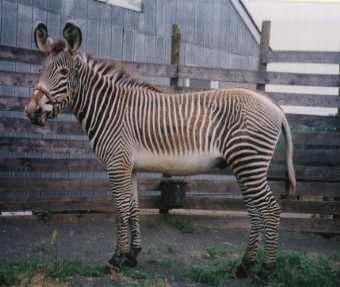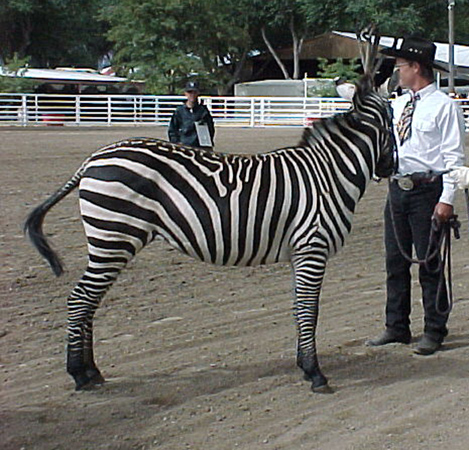
The Species of Zebras
There are three main Species of Zebra. The most common are the Plains zebras. You might hear them called Common zebras. They have several sub-types within the main group. There are the Grants, the Burchells, the Chapmans, Damarland, Selous. The extinct Quagga was probably a sub-species of the Plains type.
The second group is the Mountain Zebra. There are two sub-species remaining. One is the Hartman Mountain zebra, the other the Cape Mountain zebra. These animals have a stripe pattern that seems to be halfway between that basic patterning of the Plains types and the Grevys. They have longer, more donkey-like ears.The Mountain zebra also has a strange anatomical development that no other breed, type OR species of equine has, a "dewlap" or "wattle" of flesh under the throat. What it is for or why it is there no one knows.
The Grevy's is thought to be the oldest of the zebra types. The body is longer in shape, the head is long, the neck very short and thick. The ears are large, open curves. The striping pattern is the most distinct, with many thin stripes over the body, and a white belly. The chromosome count of the Grevy's differs significantly from other zebras.
One peculiarity about zebras is the striping patterns in relation to their locality. The more Northern species of Plain (the Grants) have the boldest striping. As they species are further south, the striping decreases. The now-extinct True Burchells zebra had almost no striping on the legs and often stripes were lacking over the rump as well. The Quagga, an extinct variant of Plains zebra, had striping only on the head and neck, and a reddish patch over the back and loins. The legs of the Quagga had little or no striping.
In spite of the fact that the ranges the different Species of zebra overlap, interbreeding in the wild is not known. It could be that the species are just varied enough that they just don't smell right to each other!
The Mountain zebra pattern looks like it could be a combination of the two patterns, but there has not been any scientific research to prove this. However, if it is some type of variation from the Grevy's and Plains, it happened a long time ago.
Are All zebras black and white?
Although most zebras are black and white, reddish stripes do occur. The foals often have red stripes, which later darken to black. There is also a pseudo-albino (white-phase) in zebras where the stripes are a "buff" or light tan color, and the eyes are blue. This is not a true albino, since that gene is absent in equines, but it does appear to be a true recessive (white) and not a dilution gene. The QUAGGA was a subspecies of Plains zebra that was striped only on the head and neck, with a reddish body!
I've heard you can't train a zebra. Why?
It used to be thought that zebras were not able to be trained. Breeding efforts by the government in past years used wild-captured stallions, which by their nature are aggressive. Modern breeders are hand-raising their breeding stock and paying more attention to the wilder nature of the zebra. Remembering that the zebra is a wild animal with NO domestic history, and treating them as such, is beginning to produce some zebras that are brought up in domestic situations. It will take many generations of such careful training, but if breeders will continue, we might someday see a more tame strain of zebra. (Remember, even dogs weren't domesticated overnight!)
